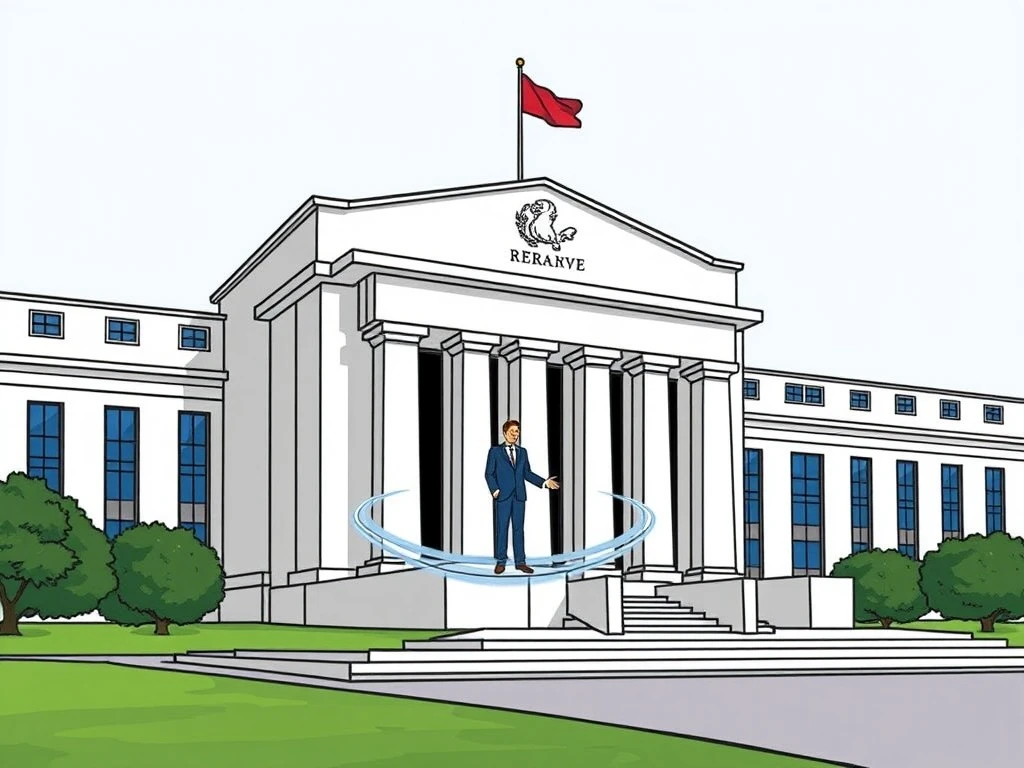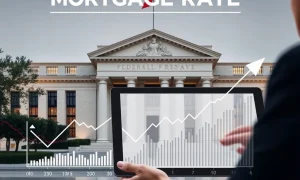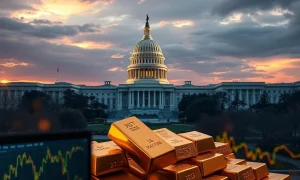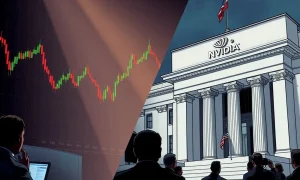The Federal Reserve, a cornerstone of global finance, often projects an image of unified consensus. However, a potential shift looms. Trump nominee Miran could significantly alter this dynamic. His presence might foster greater Miran Fed dissent. This potential change could redefine internal debates. It might also influence future policy decisions.
The Shifting Sands of Miran Fed Dissent
For decades, the Federal Reserve has prioritized a united front. This approach aims to instill market confidence. It also seeks to project stability. Public displays of disagreement are rare. Members typically present a cohesive view. This unity often masks robust internal debates. These discussions occur behind closed doors. However, Miran’s nomination introduces a new variable. His background suggests a willingness to challenge established norms. This could encourage more vocal Miran Fed dissent among officials. It represents a potentially significant change in the institution’s culture.
Understanding the Federal Reserve’s Culture of Consensus
The Federal Reserve System operates with a distinct culture. Its members value consensus highly. This emphasis ensures policy predictability. It also helps manage market expectations. Policy decisions, like interest rate adjustments, require broad agreement. Furthermore, this unity helps the Fed maintain its independence. It prevents political interference. Historically, public votes against the majority are uncommon. When they occur, they often signal deep divisions. These divisions can create market uncertainty. Therefore, the Fed actively cultivates a unified image.
Members often express their views privately. They share opinions during policy meetings. These discussions are usually candid. However, they aim to find common ground. This process leads to a single, official stance. This tradition serves a clear purpose. It minimizes confusion for investors. It also reinforces the Fed’s authority. Any departure from this norm draws significant attention. It signals a notable change in approach.
Who is Miran? A Profile in Independent Thought
Miran’s professional background provides insight into his potential impact. He brings a unique perspective to the Fed. His past roles often involved independent analysis. He has a history of questioning conventional wisdom. This trait could be particularly relevant at the Fed. Miran’s approach suggests a readiness to articulate dissenting views. He may not shy away from expressing differing opinions. This characteristic sets him apart. It contrasts with the typical consensus-driven approach.
His nomination indicates a desire for diverse viewpoints. It suggests a willingness to embrace new ideas. Furthermore, his appointment could empower others. Officials might feel more comfortable voicing their own disagreements. This could lead to a richer policy debate. Ultimately, Miran’s influence may foster a more open environment. This environment would allow for greater Miran Fed dissent. His presence could certainly challenge the status quo.
The Mechanism of Change: How Miran Could Foster Dissent
Miran’s potential influence stems from several factors. First, his own independent stance could serve as a model. Other officials might feel emboldened. They could then voice their own reservations. Second, his appointment might signal a new tolerance for disagreement. The administration’s choice itself sends a message. It suggests that differing views are welcome. Third, Miran’s specific policy leanings could spark debate. His economic philosophies may diverge from current thinking. This divergence could naturally lead to more public discussion.
Increased transparency often accompanies more dissent. Decisions might become less opaque. The public could gain better insight. They would understand the various arguments. This shift could lead to a more dynamic institution. It would also make the Fed more accountable. The potential for greater Miran Fed dissent is real. It arises from Miran’s individual style. It also comes from the broader political context. This combination could certainly reshape the Fed’s internal dynamics.
Benefits of Enhanced Miran Fed Dissent
More open dissent offers several potential advantages. Firstly, it can lead to more robust policy formulation. Diverse perspectives challenge assumptions. They force a deeper examination of issues. This process often yields better outcomes. Secondly, it enhances the Fed’s intellectual rigor. Officials must defend their positions more thoroughly. They must present stronger arguments. This strengthens the overall analytical process. Thirdly, increased transparency can build public trust. When disagreements are aired, the public sees a thorough debate. They understand the complexities involved. This can demystify the Fed’s operations.
Furthermore, it allows for greater adaptability. Different viewpoints prepare the Fed for varied economic scenarios. They prevent groupthink. This makes the institution more resilient. Ultimately, fostering Miran Fed dissent could lead to smarter, more considered policies. It could also strengthen the Fed’s long-term credibility. The benefits extend beyond internal discussions. They impact the broader economy and public confidence.
Navigating the Challenges of Increased Dissent
While dissent offers benefits, it also presents challenges. Firstly, increased public disagreement could undermine market confidence. Investors might perceive a fractured institution. This could lead to uncertainty. Markets prefer clear, unified signals. Secondly, it might complicate policy communication. Explaining nuanced differences to the public can be difficult. Misinterpretations could arise. This could affect market reactions negatively. Thirdly, it could create internal friction. Constant disagreement might hinder decision-making. It could slow down critical responses.
Furthermore, too much visible dissent might be seen as political. This could erode the Fed’s independence. It might invite more external pressure. The institution must carefully manage this balance. Maintaining a degree of unity remains crucial. The challenge lies in fostering healthy debate. It must not compromise the Fed’s core mission. The potential for more Miran Fed dissent requires careful management. It needs thoughtful consideration of its implications.
Historical Context: Moments of Miran Fed Dissent in the Past
The Federal Reserve’s history includes instances of dissent. While rare, they do occur. For example, during periods of significant economic uncertainty, some members have publicly disagreed. These moments often highlight fundamental differences. They reflect varying economic philosophies. Such dissent can signal a turning point. It can precede major policy shifts. One notable example occurred during the early 1990s. Some governors voted against interest rate hikes. They cited concerns about economic recovery. Their dissent, while ultimately overruled, highlighted valid points.
Similarly, during the 2008 financial crisis, some members voiced concerns. They questioned the scale of unconventional policies. These debates, even if not widely publicized at the time, shaped policy. They forced policymakers to consider alternatives. Understanding these past moments provides context. It shows that dissent is not unprecedented. It is a part of the Fed’s complex evolution. Miran’s potential impact could echo these historical instances. It might lead to new eras of Miran Fed dissent.
Implications for Monetary Policy and Financial Markets
Increased Miran Fed dissent could significantly impact monetary policy. Diverse opinions might lead to more cautious decisions. Policymakers could explore a wider range of options. This might result in less aggressive policy shifts. For instance, interest rate changes could become more gradual. Quantitative easing programs might face closer scrutiny. This approach could reduce the risk of unintended consequences. However, it might also slow down necessary actions. Consensus often facilitates quicker responses.
Financial markets might react in varied ways. Initially, increased dissent could introduce volatility. Traders prefer clear signals. Ambiguity can lead to uncertainty. Over time, however, markets might adapt. They could learn to interpret the nuances of debate. A more transparent Fed could even foster greater long-term stability. Investors might gain a deeper understanding. They would see the rationale behind decisions. Ultimately, the market’s reaction depends on how dissent is managed. It also depends on the clarity of communication. The shift will certainly be closely watched.
Expert Perspectives on Miran’s Potential Influence
Financial analysts and economic experts hold varying views. Some believe Miran’s appointment is a positive step. They argue that intellectual diversity strengthens institutions. It promotes better decision-making. They suggest that more open debate is healthy. It could lead to more effective policies. Others express caution. They worry about the perception of disunity. They fear it could destabilize markets. Some believe a unified front is essential. It helps the Fed navigate complex economic challenges.
Many experts agree on one point. Miran’s presence will likely change the Fed’s internal dynamics. His influence will be notable. Whether this change is ultimately beneficial remains to be seen. It depends on various factors. These include how Miran engages with colleagues. It also depends on how the Fed communicates any increased Miran Fed dissent. The outcome will shape the future of monetary policy. It will also affect the Fed’s standing.
Conclusion: A New Era for Miran Fed Dissent?
The nomination of Miran to the Federal Reserve marks a potentially pivotal moment. His individual approach could significantly alter the institution’s long-standing culture of consensus. The possibility of greater Miran Fed dissent looms large. This shift presents both opportunities and challenges. It could foster more robust policy debates. It might also lead to more transparent decision-making. However, it also carries risks. These include potential market uncertainty. They also involve challenges in public communication.
Ultimately, the impact of Miran’s tenure will unfold over time. It will depend on how effectively the Fed adapts. It will also rely on how it manages its internal dynamics. The institution’s ability to balance diverse viewpoints with a clear policy message will be crucial. This evolution could usher in a new era. It might redefine the very nature of debate within the world’s most influential central bank. The financial world will watch closely.
Frequently Asked Questions (FAQs)
Who is Miran, and why is his nomination significant?
Miran is a Trump nominee for a position within the Federal Reserve. His nomination is significant because his background and perceived independent thinking could encourage more public dissent among Fed officials, potentially altering the institution’s traditional culture of consensus.
What is the Federal Reserve’s typical approach to internal debate?
The Federal Reserve typically strives for a unified public front. While internal debates are often robust, officials usually present a consensus view to the public. This approach aims to ensure market stability and clarity in policy communication.
Why is Miran Fed dissent important for monetary policy?
Increased Miran Fed dissent could lead to more thorough and diverse policy discussions. This could result in better-vetted decisions, a wider range of explored options, and potentially more adaptable monetary policies that consider various economic perspectives and risks.
What are the potential benefits of more open dissent at the Fed?
Benefits include more robust policy formulation, enhanced intellectual rigor, increased transparency, and greater adaptability to diverse economic scenarios. It can also help prevent groupthink and potentially build greater public trust in the Fed’s decision-making process.
Are there any risks associated with increased Miran Fed dissent?
Yes, potential risks include undermining market confidence due to perceived disunity, complicating policy communication, creating internal friction that could hinder decision-making, and potentially inviting more political pressure if dissent is seen as partisan.
How might financial markets react to a more dissenting Federal Reserve?
Initially, financial markets might experience increased volatility due to uncertainty. However, over time, markets could adapt to a more transparent Fed, potentially gaining a deeper understanding of policy rationales. The long-term reaction will depend on how effectively the Fed manages and communicates its internal debates.








